VE Day was people 'dancing, singing and drinking'
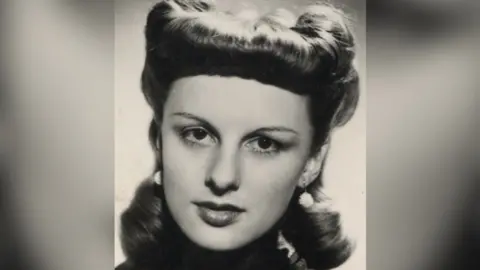 Family handout
Family handoutAs the nation prepares to celebrate VE Day, one woman shares her feelings of fear and joy as she remembers the day World War Two in Europe ended.
On 8 May 1945, Carol Hanley was a cabaret performer in London's West End and remembers seeing a "seething mass of hundreds of people" on the streets.
"They were dancing, singing, drinking, letting off fireworks.… it was terrifying," she said.
Ms Hanley, 100, who now lives in Northleach, a town near Cheltenham, was leaving work and decided - with other performers - to stay inside rather than pushing through the crowds to get home.
But after the partying died down and she found her way home, she said "everything was wonderful after the war".
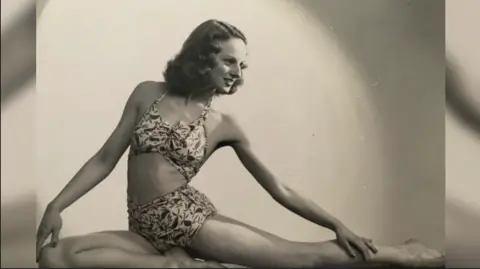 Family handout
Family handoutMs Hanley was living in Surrey when she decided to do her bit for the war effort by using her skills as a dancer.
She joined the Entertainments National Services Association (Ensa) thanks to her childhood dancing lessons.
"I [was 18] and going round the country... entertaining troops stationed here - all nationalities; Polish, American, Canadian, British," she said.
She finished with Ensa just before the end of the war and joined with three girls she knew to become a cabaret group.
Performing was her passion and she enjoyed working in London's Piccadilly nightclubs which were "very exclusive, very sophisticated and expensive," she said.
She said even as VE Day was announced, the performers were a bit isolated from it inside the club.
"I seem to remember it was quite boisterous," she said. "It wasn't anything untoward but everybody was very happy, probably more to drink than usual...
"The next day, Winston Churchill was speaking to the crowds and then the royal family came out on the balcony. I didn't get home that day [either]. So really, VE Day itself for me [in London] was quite frightening."
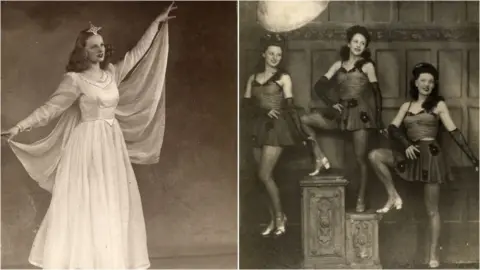 Family handout
Family handoutMs Hanley said it was during the Blitz - when the Luftwaffe dropped bombs on London and other UK cities between September 1940 and May 1941 - that she was particularly frightened.
She was working for a publisher in Fleet Street, she said, and "all the bombing and the doodlebugs and the rockets would come out of nowhere".
One day she missed her train connection to work because Clapham Junction had been bombed and the train stopped.
"When I arrived I was called into the office and asked why I was late," she said.
"I explained the trains stopped because of the bombing and they just said, 'well you should have got an earlier train, then you wouldn't have missed it'. You couldn't be late for work in those days."
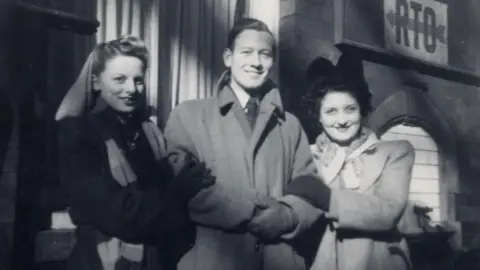 Family handout
Family handoutAfter the war, Ms Hanley's younger sister, who had been evacuated, returned home and her father was demobbed.
She said this was particularly lovely for her "poor mother" who had spent much of the war living with Ms Hanley's aunt and grandfather.
"During the war, my dad was in the army and my uncles were in the forces - one in the mortar siege, one in bomb disposal and one in the navy.
"But we didn't lose anybody so [compared to] the majority of people, we were very fortunate and after the war I remember being very happy," she added.
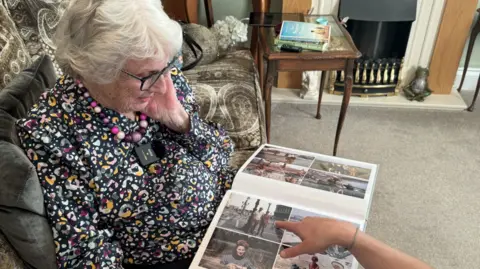
Ms Hanley married her husband John in 1950, three years after meeting in a show they were both in.
She said after travelling and performing together "he decided that showbusiness was no place for a marriage.
"We lasted 70 years of marriage which we probably wouldn't have done if we'd stayed in showbusiness [so he was right]," she said.
Ms Hanley stopped dancing and lived a "normal life", becoming a stay-at-home mum to her son Phillip before discovering yoga in 1970 which she went on to teach for about 45 years.
She said in spite of the war, she had been very fortunate to have a lovely childhood and a happy family life, especially "after the war".
Follow BBC Gloucestershire on Facebook, X and Instagram. Send your story ideas to us on email or via WhatsApp on 0800 313 4630.
